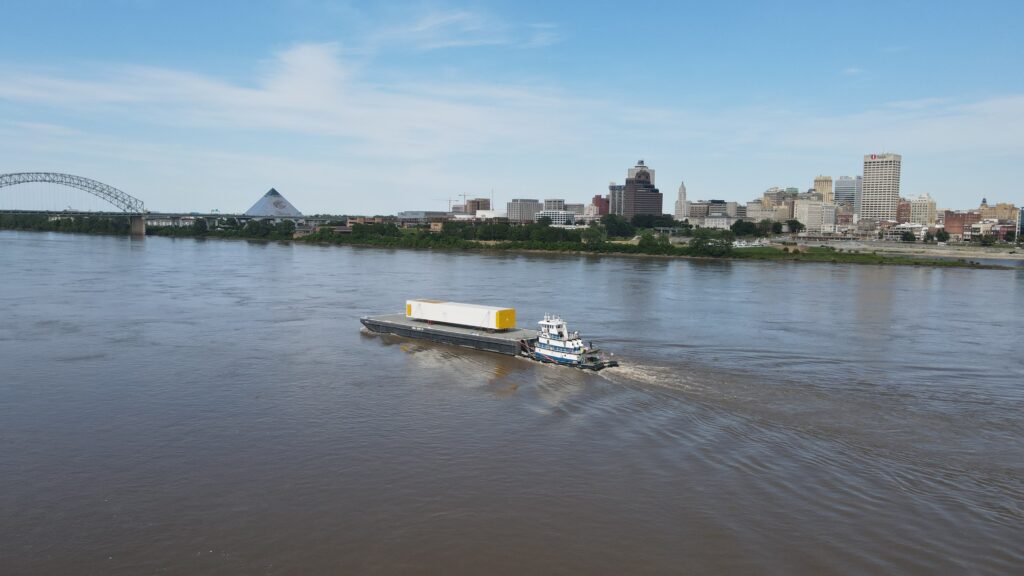From China to Canada: How Barnhart Delivered Against All Odds
When your shipment gets rerouted across the globe, frost laws shut down your route, and even the best-laid plans start falling apart, what do you do? For Barnhart, you adapt, execute, and deliver.
The project involved hauling four large cold boxes from Houston, Texas, to Edmonton, Alberta. The cargo included three smaller boxes weighing between 200,000 and 220,000 pounds each and a large one weighing 395,000 pounds. The journey covered 3,450 miles over nine months. A lot can happen in there.
Canal and Weather Challenges
Planning began in December 2023. The cargo originated in China, but due to political unrest in the Suez Canal, it was rerouted across the Pacific. Then, concerns arose about passing through the Panama Canal due to a drought. Fortunately, our vessel was granted early passage, arriving in Houston a month ahead of schedule. Barnhart swiftly mobilized to accept and stage the freight at the Port of Houston.
By late January, Frost Laws went into effect across the United States. To comply, the team added additional trailer lines to its Goldhofer, extending the trailers. Once on the road, further challenges arose. Wildfires in Texas halted the crews. The Kansas Department of Transportation (DOT) imposed a four-day Memorial Day travel restriction. North Dakota enacted its earliest frost laws in history, forcing the convoy to reroute through Montana, which added 300 miles.
A Canadian customs strike threatened delays, but it was resolved in time, preventing major disruptions. Fortunately, severe winter weather did not affect our journey.

A Strategic Move
To avoid Frost Laws, construction zones and spring road restrictions, Barnhart proposed a change order to barge the largest cold box up the Mississippi River to Minneapolis. This cut 1,600 miles of over-the-road transit from the trip. However, our preferred roll-off locations in Minneapolis were unsuitable, requiring a pivot to a new site at Alter River Terminal in St. Paul. There, the team executed the roll-off flawlessly.
With a 395,000-pound cold box in the middle of St. Paul, coordination became critical. The move required approvals from the Minnesota DOT, multiple counties and utility companies. The haul had to occur at night to minimize public disruption and ensure crew safety. Coordination included:
- Escorting by the Minnesota State Patrol
- Deployment of bucket trucks and height poles
- Posting no-parking signs for five city blocks
- Securing electrical contractors to mitigate signal lights
- Contracting multiple utility companies to mitigate power lines
Two weeks before mobilization, a key county road was unexpectedly closed due to a culvert replacement, forcing last-minute route adjustments. Fortunately, an alternate route was identified in time.
Despite potential disruptions, the impact on utility customers was minimal, with fewer outages than estimated. The cargo was successfully moved through St. Paul and the Twin Cities metro area in two night shifts.
Seamless Coordination
Once outside the metro area, the team reconnected to a proven route and transported the cargo to Saskatchewan in 16 days. Planning and execution ensured smoother-than-expected transit.
In Saskatchewan, the customer provided a specialized tandem axle Goldhofer trailer optimized for Alberta’s weight regulations for the rest of the trip. The handoff was seamless.
Executing a heavy haul project of this scale across the U.S. and Canada requires teamwork and a deep bench. Resources, personnel, and equipment from Barnhart’s Houston, Minneapolis, Los Angeles, and Mobile, Alabama branches contributed, along with Barnhart’s Canada team.
This project was a testament to adaptability, collaboration, and execution. It also highlighted the value of effective communication with the customer and those who facilitated transportation, such as regulatory agencies, utility companies, and local authorities. The result was a successful delivery for a longstanding customer.
